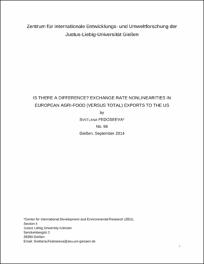Liebe Nutzerinnen und Nutzer in der Zeit von Montag 22.04. 9:00Uhr bis voraussichtlich Mitwoch 24.04. 9:00Uhr ist JLUpub aufgrund von Wartungsarbeiten nicht erreichbar. Danke für Ihr Verständnis.
Dear users, JLUpub will be unavailable from Monday 22.04. 9:00 a.m. until probably Wednesday 24.04. 9:00 a.m. due to maintenance work. Thank you for your understanding.
Is there a difference? Exchange rate nonlinearities in European agri-food (versus total) exports to the US
| dc.contributor.author | Fedoseeva, Svetlana | |
| dc.date.accessioned | 2022-08-10T13:50:45Z | |
| dc.date.available | 2015-02-13T08:13:55Z | |
| dc.date.available | 2022-08-10T13:50:45Z | |
| dc.date.issued | 2014 | |
| dc.identifier.uri | http://nbn-resolving.de/urn:nbn:de:hebis:26-opus-113192 | |
| dc.identifier.uri | https://jlupub.ub.uni-giessen.de//handle/jlupub/6303 | |
| dc.identifier.uri | http://dx.doi.org/10.22029/jlupub-5754 | |
| dc.description.abstract | Each time the Euro starts appreciating, a discussion on how painful this might hit European exporters arises in media, making politician and economists work out the ways to mitigate possible shocks. Still, in his recent study, Verheyen (2013a) using aggregated European exports to the US as an example, showed, that in the long run exports react on exchange rate changes in a nonlinear way. Particularly his analysis revealed, that a positive impact on trade during the Euro depreciation seem to outweigh the losses caused by its appreciations. In this paper, I test whether this holds true for agri-food exports as well. To address this question, I apply a partial sum decomposition approach and the NARDL framework of Shin et al. (2013) to aggregated agri-food exports as well as to total exports of eleven European countries to the US, which is currently the major partner of the EU in agri-food trade. The outcomes suggest, that the exchange rate nonlinearities are even more pronounced in agri-food than in total exports. Despite the ongoing discussion regarding the nocent effect of a strong national currency on exports, the estimation results suggest that European agri-food exporters have found their way to cope with such negative effects. European exporters seem to benefit more from Euro depreciation, than its appreciation harm them. I interpret this finding as a sign of pricing strategies application (e.g., pricing-to-market) to the European agri-food exports. | en |
| dc.language.iso | en | de_DE |
| dc.relation.ispartofseries | Discussion papers / Zentrum für Internationale Entwicklungs- und Umweltforschung; 66 | |
| dc.rights | Namensnennung - Nicht-kommerziell - Keine Bearbeitung 3.0 Deutschland | * |
| dc.rights.uri | https://creativecommons.org/licenses/by-nc-nd/3.0/de/ | * |
| dc.subject | agri-food exports | en |
| dc.subject | asymmetry | en |
| dc.subject | exchange rate nonlinearity | en |
| dc.subject | export demand | en |
| dc.subject | NARDL | en |
| dc.subject.ddc | ddc:330 | de_DE |
| dc.title | Is there a difference? Exchange rate nonlinearities in European agri-food (versus total) exports to the US | en |
| dc.type | workingPaper | de_DE |
| local.affiliation | Zentren | de_DE |
| local.opus.id | 11319 | |
| local.opus.fachgebiet | Zentrum für internationale Entwicklungs- und Umweltforschung | de_DE |



